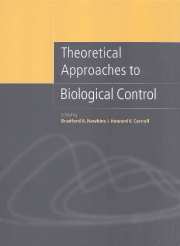Book contents
- Frontmatter
- Contents
- List of contributors
- Preface
- Part I Biological control theory: past and present
- Part II Ecological considerations
- 4 The uniformity and density of pest exploitation as guides to success in biological control
- 5 Biological control of insect pests: a tritrophic perspective
- 6 The case for indigenous generalists in biological control
- 7 Why is the parasitoid Encarsia formosa so successful in controlling whiteflies?
- 8 Parasitoid adult nutritional ecology: implications for biological control
- 9 Coexistence of multiple attractors and its consequences for a three-species food chain
- Part III Spatial considerations
- Part IV Genetic/evolutionary considerations
- Part V Microbes and pathogens
- Index
4 - The uniformity and density of pest exploitation as guides to success in biological control
from Part II - Ecological considerations
Published online by Cambridge University Press: 13 August 2009
- Frontmatter
- Contents
- List of contributors
- Preface
- Part I Biological control theory: past and present
- Part II Ecological considerations
- 4 The uniformity and density of pest exploitation as guides to success in biological control
- 5 Biological control of insect pests: a tritrophic perspective
- 6 The case for indigenous generalists in biological control
- 7 Why is the parasitoid Encarsia formosa so successful in controlling whiteflies?
- 8 Parasitoid adult nutritional ecology: implications for biological control
- 9 Coexistence of multiple attractors and its consequences for a three-species food chain
- Part III Spatial considerations
- Part IV Genetic/evolutionary considerations
- Part V Microbes and pathogens
- Index
Summary
Introduction
Quantitative theory on biological control is usually so simple as to be justifiably criticized as ‘unrealistic’ and ‘untestable’. The synthetic nature of parameters in simple models often leads to insurmountable difficulties in their accurate measurement. It is therefore hardly surprising that few field experiments (see Chapter 3), and only one relevant comparative analysis (Hawkins et al., 1993) have been expressly designed to test biological control theory.
Difficulties in the precise interpretation and measurement of parameters are only part of the reason for a reticence in testing theory. A more chronic problem is that the large body of theoretical research on biological control lacks a conceptual synthesis. We believe that the synthesis developed here will be useful to biological control specialists, because population-specific parameters measurable in the field can be related to the two concepts we introduce below.
A survey
Insect parasitoids are without doubt the most commonly employed biological control agents both in practice and in theoretical developments. Table 4.1 presents a survey of modeling studies on insect parasitoids published since Hassell's seminal monograph on the subject (Hassell, 1978). This table provides a fairly complete catalog, reflecting how both topics and modeling approaches have evolved over the past 20 years. The criteria employed for selecting studies compiled in this list are the following:
The study must be published in a scientific journal.
The study must propose a new model structure, somehow extend previous models, or apply preexisting models to a new biological problem.
[…]
- Type
- Chapter
- Information
- Theoretical Approaches to Biological Control , pp. 71 - 88Publisher: Cambridge University PressPrint publication year: 1999
- 8
- Cited by



